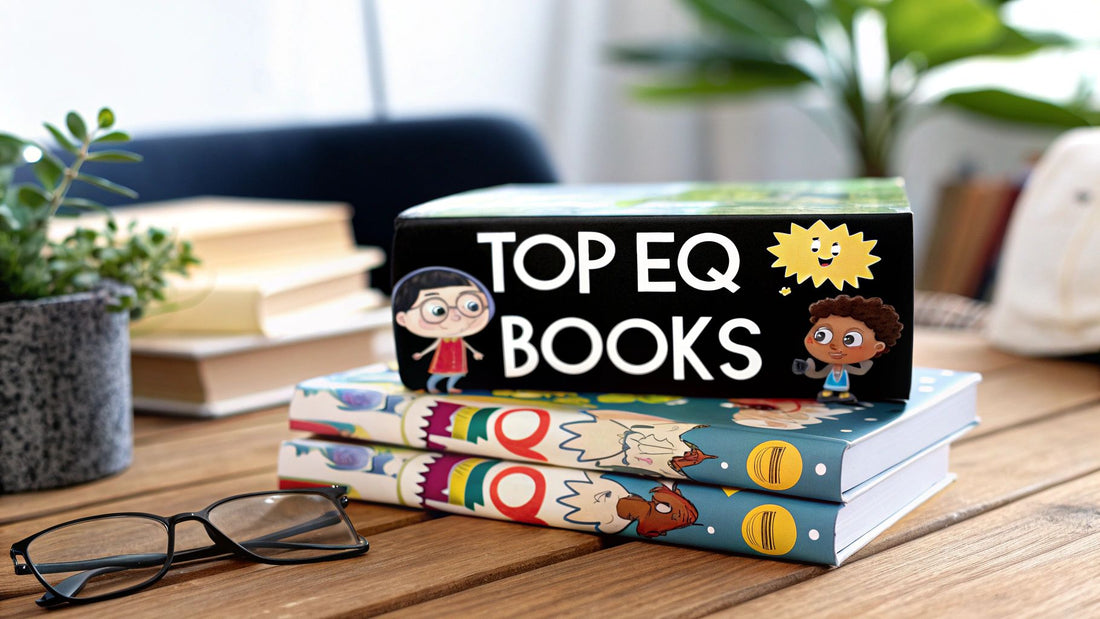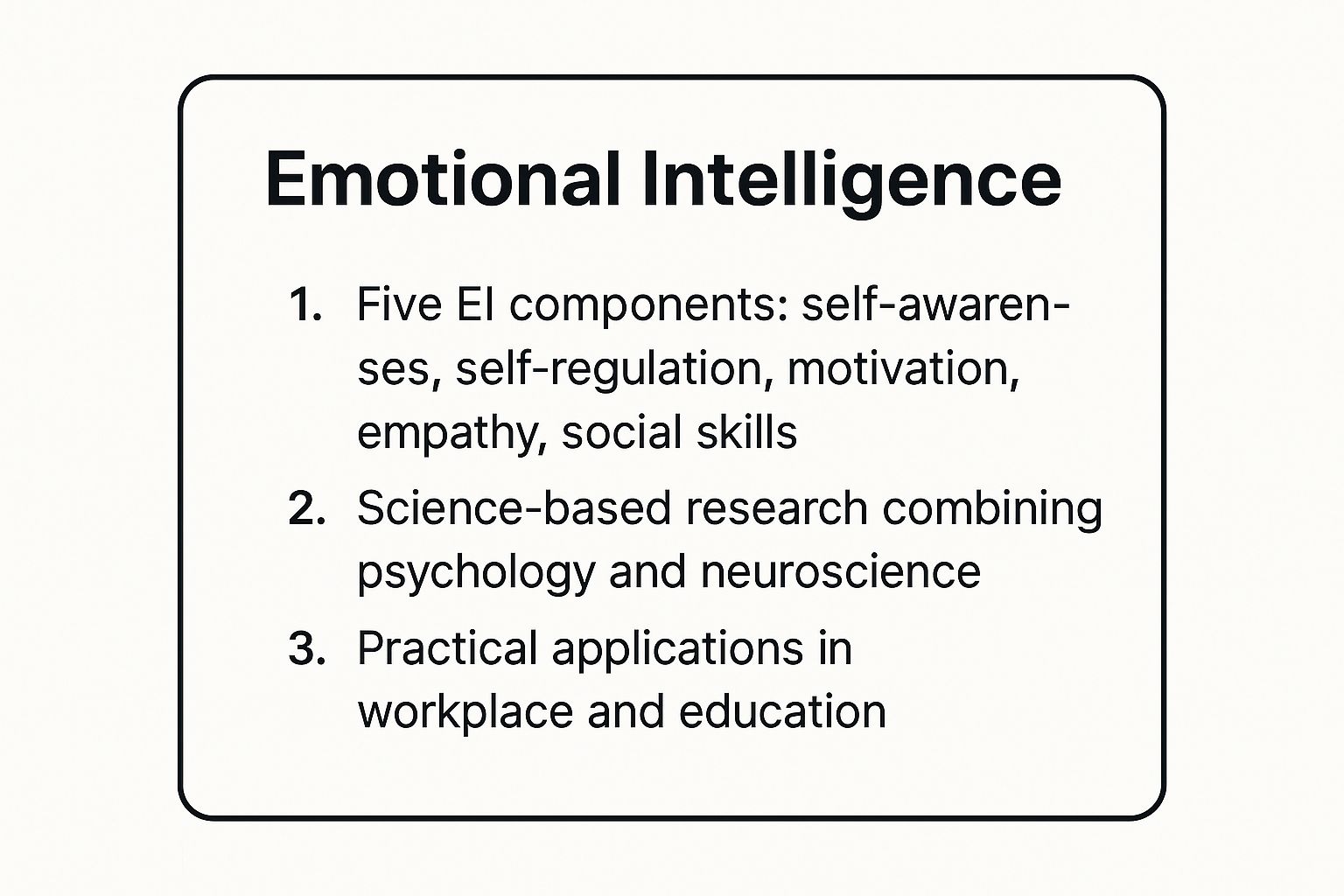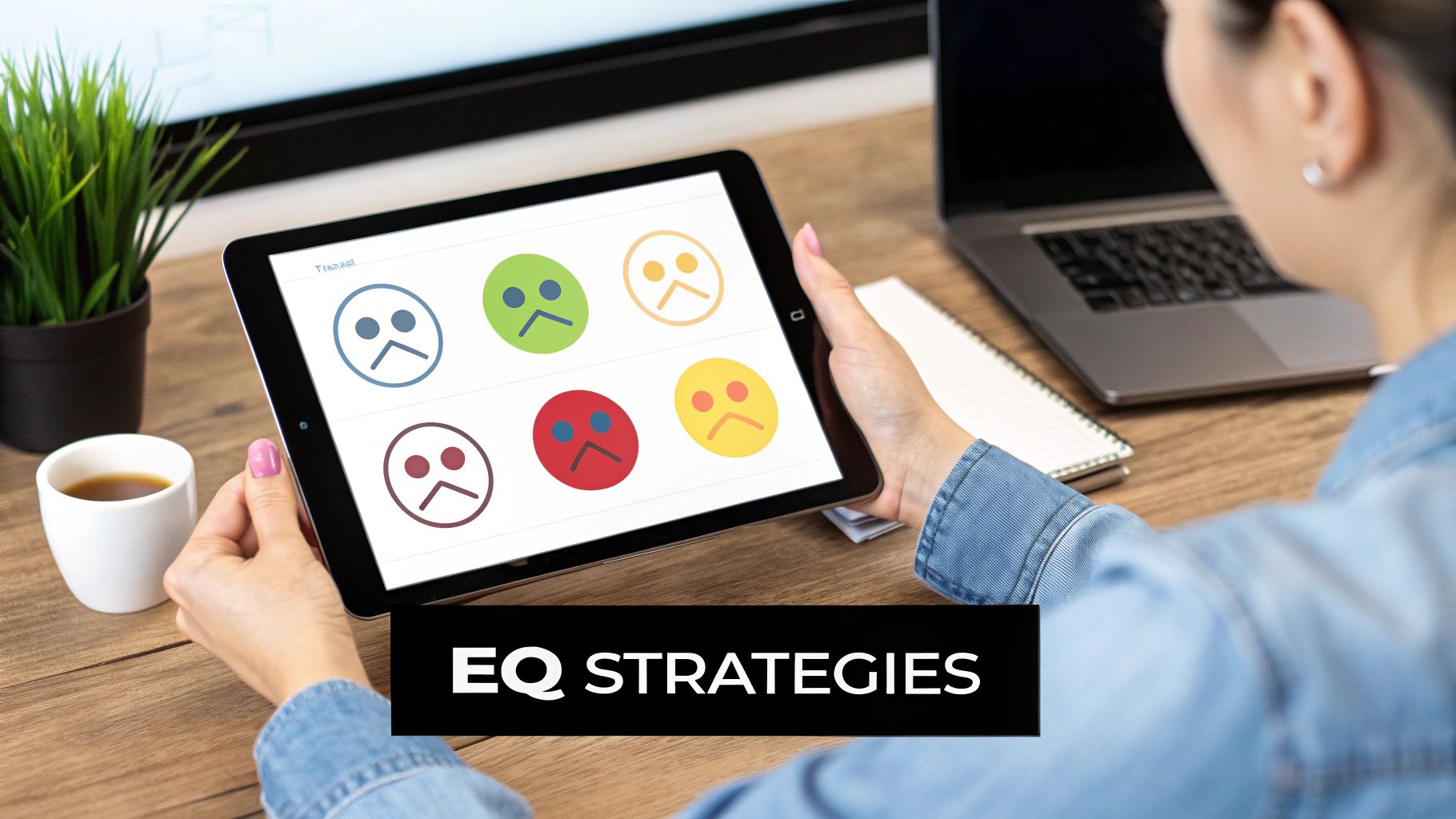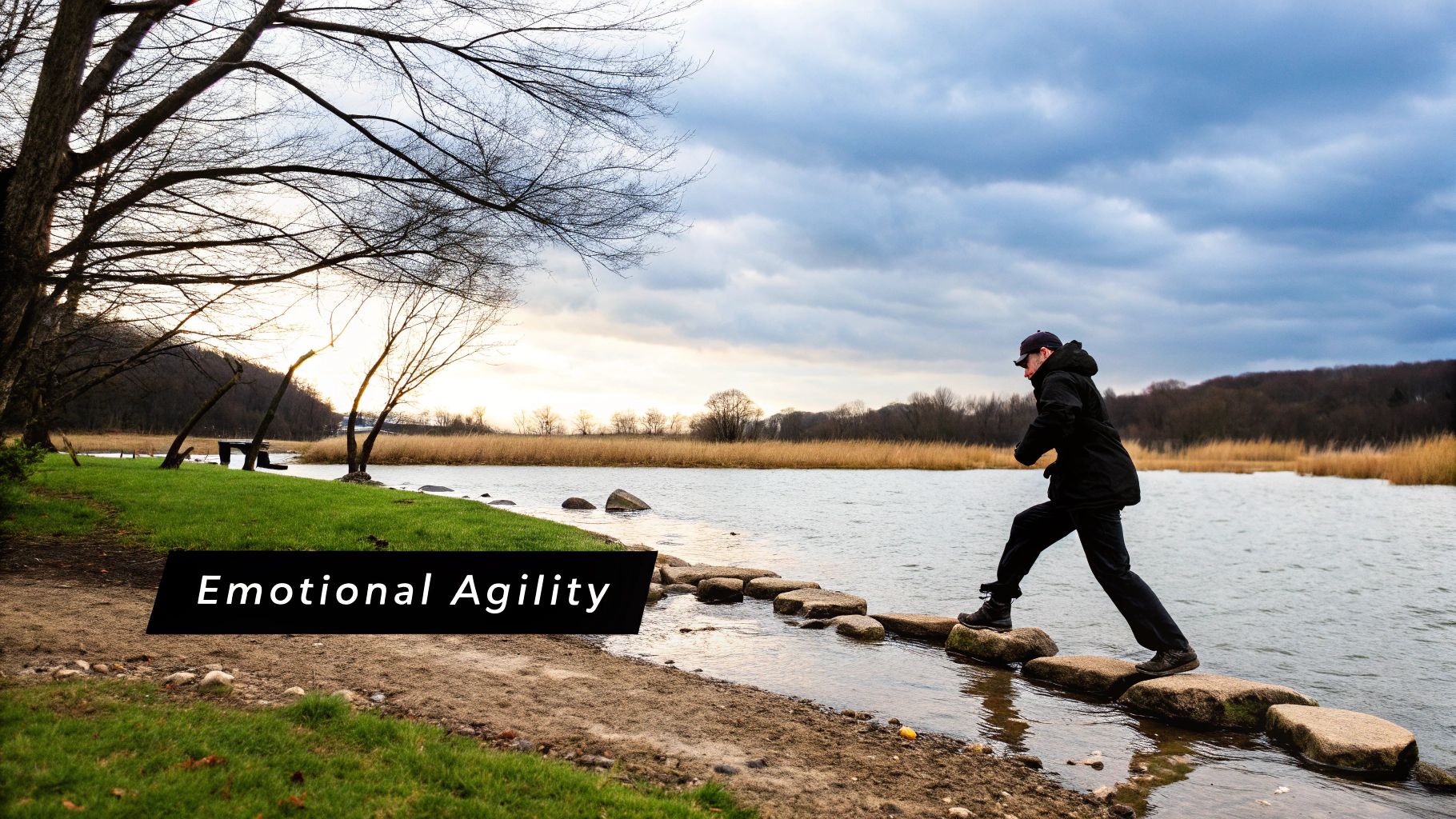
Top 10 Best Books for Emotional Intelligence in 2025
Share
In a world of constant connection and high expectations, the ability to understand and manage our emotions, and those of others, has never been more critical. This is the core of emotional intelligence (EQ), a skill set that research consistently shows is a more reliable predictor of success and well-being than traditional intelligence (IQ). For children and young people navigating the complexities of social media and academic pressures, developing a strong EQ is foundational for mental resilience. Statistics from the NHS reveal that one in six children aged 5 to 16 were identified as having a probable mental health problem in 2021, making proactive emotional education an urgent priority. It is important to address mental health early, as it builds a foundation for lifelong wellbeing, resilience, and success.
This article cuts through the noise to offer a curated guide to the best books for emotional intelligence. We move beyond theory to provide a practical resource for parents, educators, and anyone invested in nurturing the next generation. Each book on this list has been selected for its actionable insights and real-world applicability, offering clear pathways to build self-awareness, empathy, and effective relationship skills. You will discover practical tools to help young people not just cope, but truly thrive. Consider this your definitive reading list for cultivating the skills that underpin a healthy, successful, and emotionally balanced life.
1. Emotional Intelligence: Why It Matters More Than IQ by Daniel Goleman
Daniel Goleman’s groundbreaking book is arguably the cornerstone of modern emotional intelligence literature. While not written specifically for children, its foundational concepts are essential for any parent, caregiver, or educator aiming to foster emotional literacy in young people. It is one of the best books for emotional intelligence because it provides the "why" behind the "what," making a powerful, science-backed case that our ability to manage emotions is a stronger predictor of life success than raw intellectual ability (IQ).
Goleman synthesises complex research from psychology and neuroscience into an accessible framework. He argues that skills like empathy, self-awareness, and impulse control are not just "nice-to-haves" but critical components of a fulfilling life, impacting everything from relationships to professional achievement. Understanding this framework is the first step for adults who wish to model and teach these skills effectively.
Key Concepts and Implementation
The book’s core lies in its breakdown of emotional intelligence into five key components. For young people, grasping these ideas provides a roadmap for navigating the complexities of social media, academic pressure, and peer relationships. For instance, a teenager struggling with online negativity can use the self-regulation component to pause before reacting, while developing empathy helps them understand a friend's perspective. A practical example could be a child feeling jealous of a sibling's achievement; using EQ skills, they can identify the feeling, understand it stems from their own insecurity, and choose to congratulate their sibling rather than lashing out.
- Corporate Success: Companies like Johnson & Johnson have integrated Goleman's principles into leadership training, recognising that high-EQ leaders create more collaborative and productive teams.
- Educational Programmes: Schools worldwide have adopted social-emotional learning (SEL) curricula directly influenced by Goleman's work, leading to improved student behaviour and academic outcomes.
The following infographic offers a quick reference to the book's central ideas.

This summary highlights how Goleman's framework blends scientific rigour with real-world utility, making it a timeless resource.
Actionable Tips for Development
To translate Goleman's theories into practice, focus on building one skill at a time.
- Start with an Emotion Journal: Encourage your child to write down their feelings daily without judgment. This simple act builds self-awareness, helping them recognise emotional patterns over time.
- Practise Mindful Moments: Introduce short, one-minute breathing exercises to help with self-regulation during stressful moments, like before an exam.
- Focus on Empathy: When watching a film or reading a book together, ask questions like, "How do you think that character is feeling right now?" to cultivate perspective-taking.
2. Emotional Intelligence 2.0 by Travis Bradberry and Jean Greaves
If Goleman's work provides the foundational "why," then Emotional Intelligence 2.0 delivers the practical "how." Travis Bradberry and Jean Greaves have created a direct, actionable guide designed to help individuals tangibly increase their emotional intelligence. Its inclusion as one of the best books for emotional intelligence is due to its simple, step-by-step programme and the inclusion of the online Emotional Quotient Appraisal®, which allows readers to measure their EQ before and after implementing the book’s strategies.

This book moves beyond theory into a hands-on improvement plan. It organises emotional intelligence into four core skills: self-awareness, self-management, social awareness, and relationship management. For each skill, the authors provide 66 distinct strategies that can be practised and mastered, making personal growth a clear and achievable goal for adults and older teenagers alike.
Key Concepts and Implementation
The book’s strength lies in its real-world applicability, bridging the gap between knowing about emotional intelligence and actually improving it. The strategies are designed for immediate use in daily life, helping readers navigate complex social situations, manage stress, and build stronger connections. For young people facing the pressures of social media, which can significantly impact mental health by fostering comparison and anxiety, skills like self-management are vital for building resilience.
- Corporate Performance: L'Oreal discovered that salespeople selected based on emotional intelligence competencies outsold their peers by over £2 million, demonstrating a clear link between EQ and business success. The cost of mental health on businesses is substantial; a 2022 Deloitte report found that poor mental health costs UK employers up to £56 billion per year.
- Customer Service Excellence: Sheraton Hotels used emotional intelligence training to enhance customer service, leading to improved guest satisfaction and market share.
- High-Stakes Recruitment: The US Federal Bureau of Investigation (FBI) has utilised emotional intelligence principles to select agents who can handle high-stress situations effectively.
This evidence-based approach makes the book a powerful tool for anyone serious about personal and professional development.
Actionable Tips for Development
To get the most out of Emotional Intelligence 2.0, approach it as a personal training programme.
- Take the EQ Assessment First: Before diving in, complete the online assessment to get a baseline score. This will highlight your strengths and pinpoint the specific areas you need to develop.
- Focus on One Strategy at a Time: Resist the urge to try everything at once. Choose one of the 66 strategies that targets a weak area and practise it consistently for two to three weeks before moving on.
- Seek Constructive Feedback: Ask a trusted friend, family member, or colleague to provide feedback on any changes they notice in your behaviour. This external perspective is invaluable for tracking genuine progress.
- Re-Test to Measure Growth: After six months of dedicated practice, retake the assessment to see a measurable improvement in your EQ score.
3. The EQ Edge: Emotional Intelligence and Your Success by Steven J. Stein and Howard E. Book
Steven J. Stein and Howard E. Book offer a data-driven approach to emotional intelligence, grounded in the widely-used EQ-i assessment. The EQ Edge is one of the best books for emotional intelligence because it moves beyond theory and provides a structured, scientific framework for measuring and improving specific competencies. It demystifies emotional skills, presenting them not as vague personality traits but as a set of 15 measurable abilities that can be systematically developed.
This book provides a comprehensive roadmap for anyone looking to build practical EQ skills in themselves or in young people. The authors translate complex psychological research into actionable strategies, making a clear case that emotional and social competencies are critical for success in every area of life. For parents and educators, this book is an invaluable tool for identifying specific areas of emotional development needing support, such as impulse control or empathy.
Key Concepts and Implementation
The book's strength lies in its detailed breakdown of 15 emotional intelligence competencies, including stress tolerance, optimism, and interpersonal relationships. This granular approach allows readers to pinpoint specific strengths and weaknesses. For a young person facing the pressures of social media, which can significantly impact mental health, understanding their own stress tolerance level is the first step towards building resilience.
- Professional Selection: The Royal Canadian Mounted Police have used the EQ-i assessment, the basis of this book, to help in the selection process for officers, ensuring candidates have the emotional resilience required for the role.
- Healthcare Improvements: Healthcare organisations have used the principles in The EQ Edge to train staff, leading to better teamwork, reduced stress, and improved patient satisfaction scores.
This evidence-based model shows how targeted emotional skill development can yield tangible, positive outcomes in high-stakes environments.
Actionable Tips for Development
To apply the book's principles, it's effective to focus on improving one competency at a time.
- Identify Development Areas: If you have access to an EQ-i assessment, focus on understanding your lowest-scoring competencies first. If not, use the book's descriptions to self-assess where growth is needed.
- Practise Daily Stress Management: Introduce a non-negotiable five-minute daily practice, such as deep breathing or a short walk without a phone, to build the "stress tolerance" muscle.
- Seek Constructive Feedback: Encourage your teen to ask a trusted teacher or friend for specific feedback on their communication style or how they handle group projects, which helps develop interpersonal skills.
4. Primal Leadership: Realizing the Power of Emotional Intelligence by Daniel Goleman, Richard Boyatzis, and Annie McKee
While focused on the professional world, Primal Leadership offers invaluable lessons for parents, educators, and mentors who are, in essence, the primary leaders in a young person’s life. Co-authored by Daniel Goleman, Richard Boyatzis, and Annie McKee, the book argues that a leader’s most fundamental task is to manage their own emotions and those of their team. It stands out as one of the best books for emotional intelligence because it directly links a leader's emotional state to the performance and well-being of their group, a principle that applies as much to a classroom or family as it does to a boardroom.

The authors introduce the concept of "resonance," where a leader’s optimism and energy spread through a team, and "dissonance," where negativity and anxiety create a toxic environment. This is critical in the context of youth mental health, where an adult’s emotional climate can significantly impact a child’s sense of security and resilience. The book provides a practical framework for becoming a resonant leader who inspires growth and emotional stability.
Key Concepts and Implementation
Primal Leadership identifies six distinct leadership styles, each suited to different situations. For adults guiding young people, understanding these styles allows for a more flexible and effective approach. For example, the "Coaching" style is perfect for helping a teenager discover their passions, while the "Authoritative" style can provide clear direction and security during a family crisis.
- Corporate Culture: The culture at Southwest Airlines, known for its positive employee-customer interactions, exemplifies resonant leadership by prioritising emotional connection.
- Leadership Development: Companies like Johnson Controls have used the book's principles to train managers, leading to higher team engagement and lower staff turnover.
- Change Management: Novartis successfully applied resonant leadership principles to guide teams through significant organisational changes, maintaining morale and productivity.
The following video provides further insight into the core ideas presented in the book.
Actionable Tips for Development
To apply these leadership concepts, adults can focus on cultivating resonance in their daily interactions with young people.
- Practise Situational Styles: Consciously choose a leadership style based on the need. Use the "Affiliative" style (focusing on emotional bonds) during a family dinner to build harmony, but switch to a "Pacesetting" style (leading by example) when working on a challenging school project together.
- Conduct Emotional Check-ins: Regularly ask young people, "How are we all feeling today?" This normalises conversations about emotions and helps you gauge the emotional climate of your family or classroom.
- Develop Coaching Skills: Instead of giving answers, ask open-ended questions like, "What do you think the next step should be?" This empowers young people to develop their own problem-solving skills and emotional self-reliance.
5. The Emotionally Intelligent Nurse Leader by Esta Bigler
While aimed at healthcare professionals, Esta Bigler's specialised guide offers profound insights for anyone navigating high-stress environments, including parents and educators. This book is one of the best books for emotional intelligence because it demonstrates how to apply these skills under immense pressure, a scenario many young people face with academic and social demands. It provides a blueprint for maintaining empathy, composure, and effective communication when stakes are high.
Bigler translates core emotional intelligence principles into the demanding world of nursing, focusing on resilience, team dynamics, and compassionate care. For a family supporting a child through a health crisis or a teacher managing a difficult classroom situation, the strategies for de-escalation, active listening, and self-regulation are directly transferable and immensely valuable. The book makes a compelling case that emotional skill is as critical as technical proficiency in achieving positive outcomes.
Key Concepts and Implementation
The book’s strength lies in its practical application of emotional intelligence to crisis management and team cohesion. It provides a framework for building resilience and preventing burnout, issues that are increasingly relevant to young people’s mental health. For instance, a student feeling overwhelmed by exam stress can use the emotional regulation techniques designed for nurses in emergencies to stay calm and focused.
- Healthcare Improvement: Hospitals implementing Bigler’s principles have seen tangible results, such as reduced nurse turnover and improved patient satisfaction scores, by fostering more supportive and communicative work environments.
- Leadership Development: The American Organization of Nurse Executives and other healthcare leadership programmes use this framework to train leaders who can manage team conflict and lead with empathy.
This focused approach provides a powerful model for anyone looking to build emotional fortitude in challenging circumstances. It's a key reason why nurturing young minds for emotional support is so critical in today's fast-paced world.
Actionable Tips for Development
To adapt Bigler’s healthcare-centric advice for broader use, focus on its core principles of empathy and regulation.
- Practise Empathy Exercises: Encourage your child to consider the perspective of others in conflict. Ask, "What might the other person be feeling to make them act that way?" This mirrors the patient-centred approach in the book.
- Develop Crisis Regulation Techniques: Teach simple grounding techniques for moments of high anxiety, like focusing on the five senses. This is similar to how nurses are trained to stay calm during medical emergencies.
- Create Supportive Communication Protocols: Establish family rules for difficult conversations, such as "we listen without interrupting" or "we focus on the problem, not the person," to mirror the team communication protocols Bigler advocates.
6. Emotional Agility: Get Unstuck, Embrace Change, and Thrive in Work and Life by Susan David
Susan David’s influential work offers a refreshing and powerful alternative to the pressure of constant positivity. This book is a standout in the field of emotional intelligence because it teaches us how to navigate the full spectrum of human emotions, not just the happy ones. David, a Harvard Medical School psychologist, provides a science-backed framework for becoming more adaptable and resilient by learning from our difficult feelings instead of suppressing them or letting them take control.

The concept of emotional agility is about being flexible with your thoughts and feelings so you can respond to life's challenges in a way that aligns with your core values. For young people navigating the complexities of social media and academic stress, this is a crucial skill. It empowers them to acknowledge their feelings of anxiety or disappointment without getting "hooked" by them, fostering a healthier relationship with their inner world. Understanding this is a vital part of nurturing your child's mental health.
Key Concepts and Implementation
David's framework is built on four key practices: showing up, stepping out, walking your why, and moving on. These steps guide individuals to face their emotions with curiosity, detach from unhelpful internal narratives, and act in accordance with their deepest values. For a teenager facing peer pressure, this means acknowledging the feeling of wanting to fit in (showing up), recognising the thought "I have to do this to be popular" as just a thought, not a command (stepping out), and choosing an action based on their value of integrity (walking your why).
- Corporate Wellness: Companies like Google and Ernst & Young have implemented emotional agility and resilience training, recognising its impact on employee wellbeing and performance. The cost of mental health on businesses is significant, and such programmes help create a more supportive and productive workforce.
- Individual Success: The principles are widely used in therapy and coaching to help individuals overcome personal and professional hurdles, from career changes to managing anxiety.
Actionable Tips for Development
To cultivate emotional agility in your family, try integrating these small but powerful practices.
- Practise Emotion Labelling: Instead of saying, "I am sad," encourage your child to say, "I am noticing the feeling of sadness." This simple shift creates psychological distance and reduces the power of the emotion.
- Identify Core Values: Have a family discussion about what truly matters to you all, such as kindness, honesty, or courage. Use these values as a compass when making decisions.
- Focus on Tiny Tweaks: David emphasises small, deliberate actions over major overhauls. Encourage making tiny, value-aligned changes daily, which compound over time to build lasting resilience.
7. The Happiness Track: How to Apply the Science of Happiness to Accelerate Your Success by Emma Seppälä
Emma Seppälä’s research-packed book turns the conventional wisdom about success on its head. Instead of promoting the "hustle culture" that often leads to burnout, especially among young people facing immense academic and social pressures, Seppälä argues that happiness is the true fuel for achievement. This makes The Happiness Track one of the best books for emotional intelligence because it provides a science-backed alternative to the high-stress, high-pressure pathway to success.
Drawing from her work at Stanford and Yale, Seppälä presents compelling evidence that states of calm, compassion, and mindfulness are not obstacles to success but are essential for it. For teenagers and young adults, this is a revolutionary idea. It reframes emotional well-being not as a luxury to be enjoyed after success is achieved, but as a prerequisite for sustainable performance, creativity, and resilience in a world where social media constantly amplifies the pressure to perform.
Key Concepts and Implementation
The book’s power lies in its practical strategies for cultivating well-being to enhance professional and personal outcomes. Seppälä deconstructs the myth that stress is a necessary evil, showing how it impairs cognitive function and long-term health. By prioritising emotional balance, young people can build the focus and resilience needed to navigate challenges without sacrificing their mental health, a critical skill in today's demanding environment.
- Corporate Wellness: Google’s renowned mindfulness programmes, which focus on improving employee well-being and performance, reflect Seppälä’s core principles of integrating calm and presence into the workday.
- Resilience Training: The US military has incorporated compassion and resilience practices into its training programmes, helping service members manage the intense stress of their roles more effectively.
Actionable Tips for Development
To put Seppälä's research into practice, focus on small, consistent habits that prioritise well-being.
- Start with Five-Minute Breathing: Introduce a short, daily breathing exercise. This simple practice can calm the nervous system, improve focus before studying, and manage feelings of overwhelm.
- Practise Self-Compassion: Encourage a kinder inner voice during setbacks. Instead of self-criticism after a poor grade, prompt a thought like, "This was difficult, but I can learn from it."
- Focus on Present-Moment Awareness: When working on a task, try to minimise distractions and fully engage with the activity at hand. This builds focus and reduces the mental load of multitasking. For relaxation, try progressive muscle relaxation: tense and then release different muscle groups, from your toes to your head, to release physical tension.
8. Permission to Feel: Unlocking the Power of Emotions to Help Our Kids, Ourselves, and Our Society Thrive by Marc Brackett
Marc Brackett, founding director of the Yale Centre for Emotional Intelligence, offers a powerful and practical framework for understanding our emotional lives. His book argues that society often implicitly denies us "permission to feel" the full spectrum of human emotion, favouring relentless positivity. This makes it one of the best books for emotional intelligence because it provides a clear, actionable system called RULER to help children and adults become "emotion scientists" rather than emotion judges.
Brackett’s work is built on decades of research showing that ignoring or suppressing feelings leads to poor outcomes in mental health, relationships, and performance. By giving both children and ourselves the validation to experience all emotions, we can then learn to manage them constructively. This approach is crucial in an era where social media often presents a filtered, unrealistic version of life, putting immense pressure on young people.
Key Concepts and Implementation
The book’s power lies in the RULER method, an acronym for Recognising, Understanding, Labelling, Expressing, and Regulating emotions. This simple yet profound sequence provides a universal language for navigating our inner worlds. For a child feeling overwhelmed by schoolwork, RULER helps them move from a vague sense of distress to identifying the specific feeling as anxiety, understanding its cause, and choosing a strategy to manage it, like talking to a parent.
- Educational Programmes: The RULER curriculum has been implemented in thousands of schools, leading to reduced anxiety and depression, improved academic performance, and a more positive school climate.
- Corporate Integration: Companies like Facebook have collaborated with Brackett to develop tools and research based on his principles, recognising the impact of emotional skills on workplace wellbeing and productivity.
The RULER method provides a structured yet flexible approach to teaching emotional awareness to children, making abstract feelings concrete and manageable.
Actionable Tips for Development
To integrate Brackett's framework into daily life, focus on making emotional check-ins a regular habit.
- Use the Mood Meter: Brackett’s Mood Meter app helps families expand their emotional vocabulary beyond "happy" or "sad," plotting feelings based on their energy and pleasantness.
- Practise the Meta-Moment: Teach children to use this technique: sense an emotional trigger, pause before reacting, see their "best self," and then choose a strategy to respond thoughtfully.
- Create Family Check-ins: Start dinner by asking, "Where are you on the Mood Meter right now?" This normalises emotional conversations and builds connection.
Disclaimer: Please note, I am not a mental health professional. The information and resources provided in this article are for informational purposes only and are not a substitute for professional medical advice, diagnosis, or treatment. If you are worried about your child's or your own mental health, it is important to seek help from a doctor or a qualified mental health provider.
Top 8 Emotional Intelligence Books Comparison
| Title | Implementation Complexity 🔄 | Resource Requirements ⚡ | Expected Outcomes 📊 | Ideal Use Cases 💡 | Key Advantages ⭐ |
|---|---|---|---|---|---|
| Emotional Intelligence: Why It Matters More Than IQ by Daniel Goleman | Moderate – theoretical framework with practical tips | Low to moderate – reading and self-practice | Broad understanding of EI; improved self-awareness and social skills | Workplace, education, personal development | Groundbreaking, research-backed, broad applicability |
| Emotional Intelligence 2.0 by Travis Bradberry and Jean Greaves | Low to moderate – practical step-by-step programme | Moderate – includes online EQ assessment | Measurable EQ improvement; actionable skill-building | Personal development, corporate training | Practical strategies, professional EQ assessment |
| The EQ Edge: Emotional Intelligence and Your Success by Steven J. Stein and Howard E. Book | High – technical, assessment-based | High – requires professional EQ-i assessment | Comprehensive EI competency development and cultural considerations | Clinical, organizational settings | Scientifically validated, extensive competency coverage |
| Primal Leadership: Realizing the Power of Emotional Intelligence by Goleman, Boyatzis & McKee | Moderate – leadership-specific EI application | Moderate – suited for leaders and managers | Enhanced leadership effectiveness and organisational climate | Leaders, managers, executives | Leadership styles framework, clear business impact |
| The Emotionally Intelligent Nurse Leader by Esta Bigler | Moderate – healthcare-focused application | Moderate – requires healthcare context knowledge | Improved nursing leadership, stress management, patient care | Healthcare professionals, nursing leadership | Healthcare-specific, practical strategies for clinical settings |
| Emotional Agility: Get Unstuck, Embrace Change by Susan David | Moderate – psychological flexibility focus | Low to moderate – self-reflection and practice | Greater emotional flexibility and values-based living | Personal growth, professional resilience | Unique psychological flexibility approach, Harvard-backed |
| The Happiness Track: How to Apply Science of Happiness by Emma Seppälä | Low to moderate – positive psychology and mindfulness | Low – mindfulness and compassion exercises | Improved well-being and success through happiness | General wellbeing, stress reduction | Strong scientific base, holistic success approach |
| Permission to Feel: Unlocking the Power of Emotions by Marc Brackett | Moderate – systematic RULER method application | Moderate – consistent practice and tech tools | Enhanced emotional recognition and regulation | Parenting, education, organisational training | Systematic, research-based, strong emotional vocabulary focus |
Your Next Steps on the Path to Emotional Mastery
Navigating the landscape of emotional intelligence can feel like learning a new language, but as the books we have explored demonstrate, it is a language of profound connection, resilience, and success. From Daniel Goleman’s foundational work establishing why EQ often matters more than IQ, to Marc Brackett’s practical RULER framework in Permission to Feel, each author provides a unique lens through which to understand and harness the power of our emotions. The journey through these pages is not just an academic exercise; it is an invitation to cultivate deeper self-awareness, build stronger relationships, and lead a more fulfilling life.
The core message woven through these essential texts is clear: emotional intelligence is not a fixed trait but a dynamic skill set that can be learned, practised, and mastered. Whether it is Susan David’s concept of 'emotional agility' teaching us to navigate life’s twists and turns, or Travis Bradberry's actionable strategies in Emotional Intelligence 2.0, the path to improvement is well-defined. These are not just abstract theories; they are practical toolkits for real-world challenges.
Putting Knowledge into Action
Simply reading about emotional intelligence is the first step. The true transformation happens when you begin to integrate these principles into your daily life. Here are some actionable next steps to turn theory into practice:
- Start an Emotion Journal: Inspired by Marc Brackett’s work, take five minutes each day to label your feelings. Ask yourself: What am I feeling? What caused this feeling? This simple act builds the crucial skill of self-awareness.
- Practise Active Listening: The next time you are in a conversation, focus entirely on what the other person is saying without planning your response. Pay attention to their tone and body language. This enhances your empathy, a cornerstone of social awareness.
- Conduct a 'Pattern Interrupt': When you feel a strong negative emotion rising, use a technique from Susan David’s Emotional Agility. Pause, take a deep breath, and create a small space between the emotional trigger and your reaction. This allows you to choose your response rather than being controlled by your feelings.
For those in leadership or organisational roles, embedding these skills within a team is a powerful next step. Beyond reading, consider practical applications like emotional intelligence training for employees to further develop these crucial skills in a professional context. This structured approach can transform workplace culture, improve collaboration, and boost overall productivity.
The journey to mastering emotional intelligence is ongoing. The best books for emotional intelligence are merely the signposts; you are the one who must walk the path. By committing to this journey, you are not only investing in your own well-being and success but also contributing to a more empathetic and understanding world for everyone around you. Wearing mental health apparel can also be a simple yet powerful way to normalise these conversations and show support for emotional wellbeing in your community.
Ready to introduce these vital concepts to the youngest members of your family? Explore the beautifully illustrated and thoughtfully written stories from Little Fish Books. Our collection is specifically designed to help children understand and manage their big feelings, making them some of the best books for emotional intelligence for the next generation.
